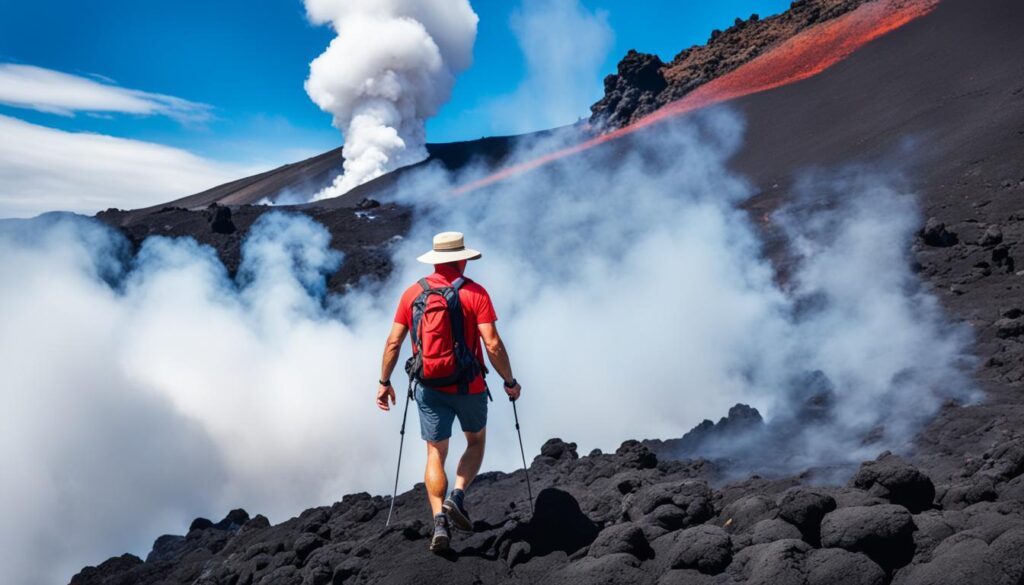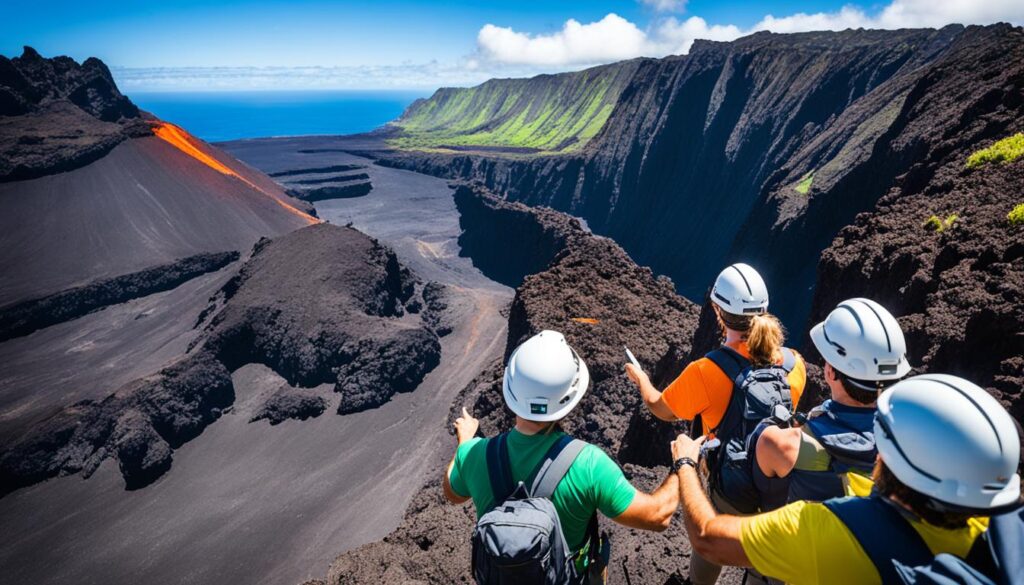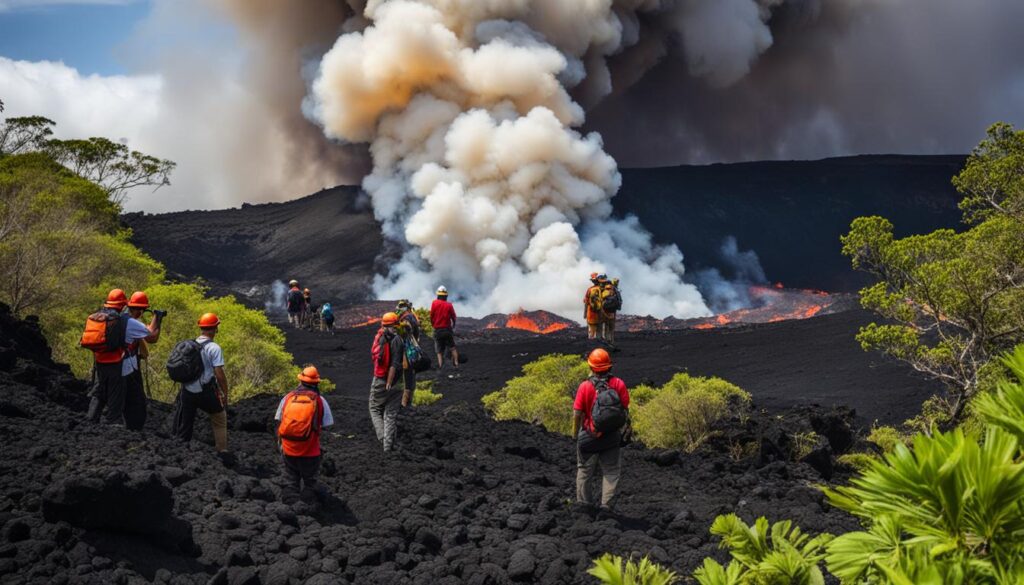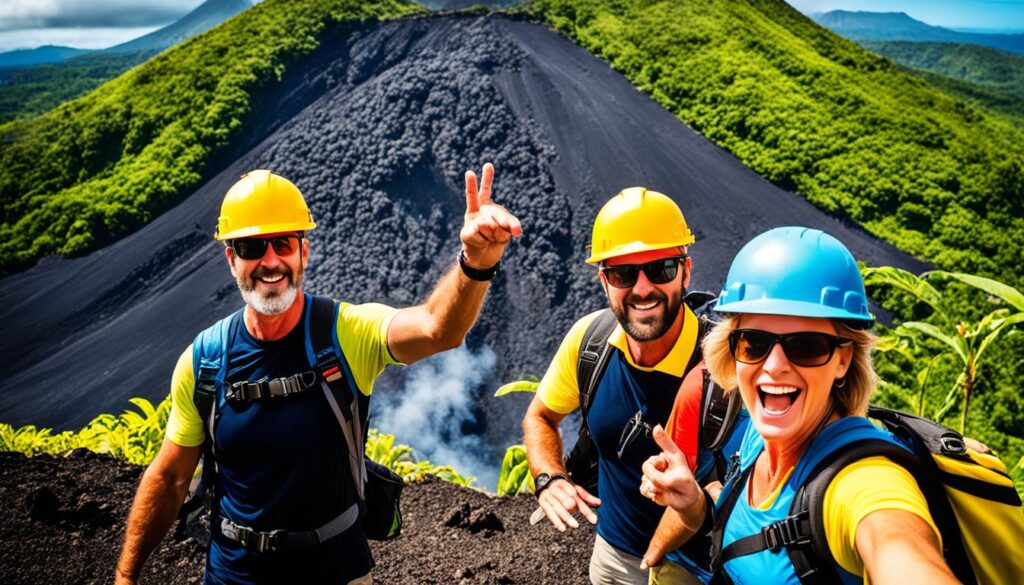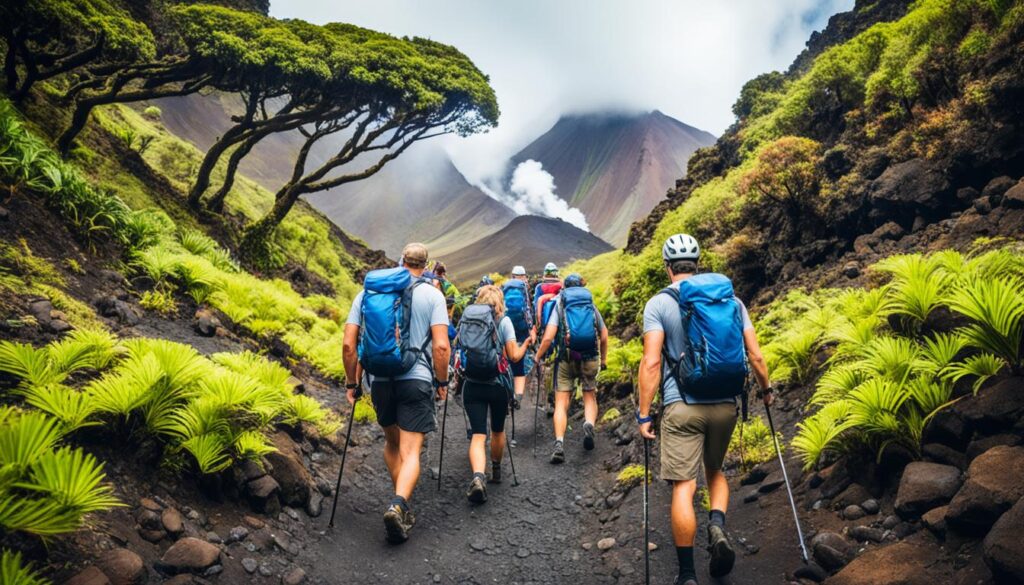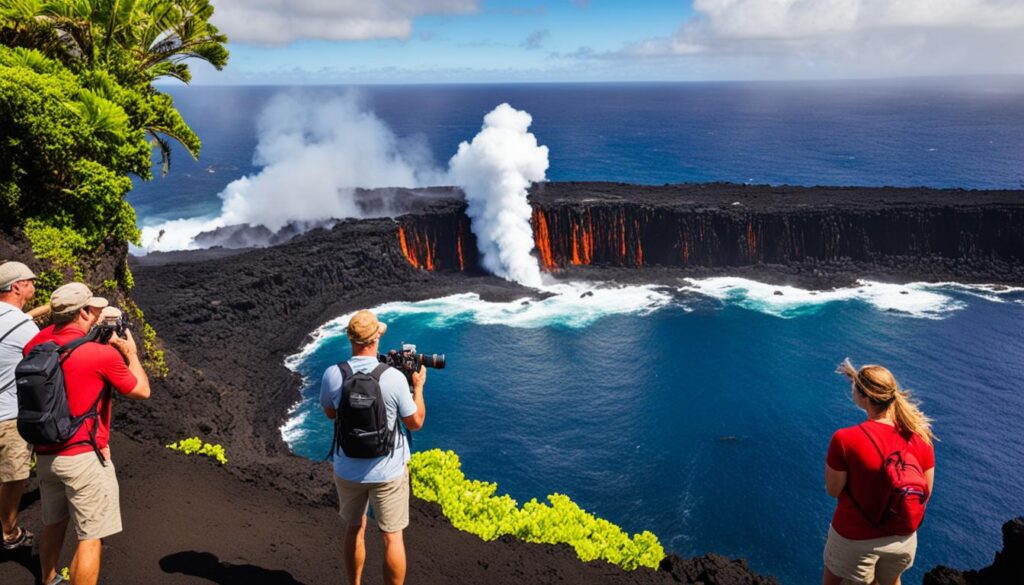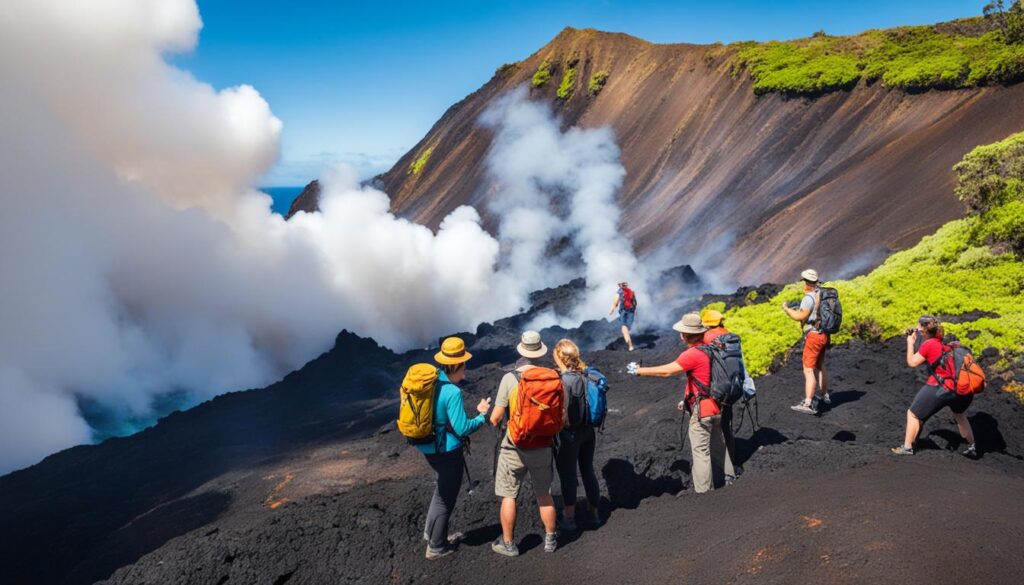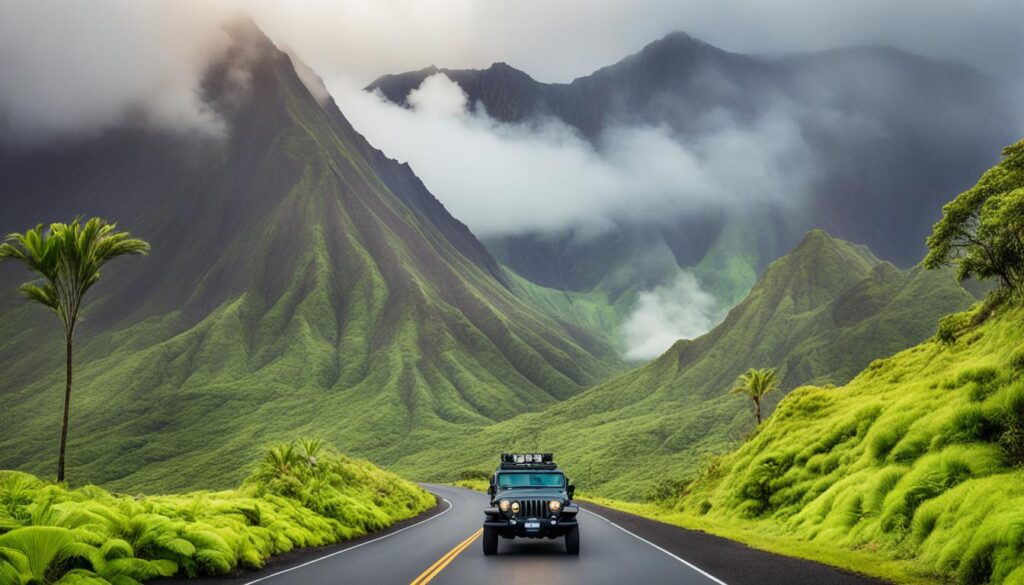Are you planning a visit to the captivating volcanoes of Hawaii Island? Before you embark on this adventure, it’s essential to ensure your safety and well-being.
With Hawaii Island volcano tours becoming increasingly popular, it’s important to be equipped with the necessary knowledge and skills to make the most of your experience while staying safe. From volcano safety tips to best practices for visiting Hawaii’s volcanoes, we’ve got you covered.
Are you ready to discover the mesmerizing geological wonders and witness nature’s power firsthand? Let’s dive into the world of Hawaii’s volcanoes and explore how you can have an unforgettable and responsible volcano tour experience.
Understanding the Volcanic Environment in Hawaii
Before embarking on a volcano tour in Hawaii, it’s essential to have a good understanding of the unique volcanic environment. Hawaii’s volcanic sites offer awe-inspiring landscapes and fascinating geological features, making them popular destinations for visitors from around the world.
When exploring these volcanic sites, it’s important to be aware of the potential hazards associated with volcanic activities. Volcanoes are dynamic and ever-changing, and being prepared and informed can ensure a safe and memorable experience during your visit.
“Hawaii’s volcanic environment is truly one-of-a-kind, providing a glimpse into the Earth’s powerful forces at work. It’s a captivating experience that reminds you of the planet’s constant transformation.” – Geologist Sandra Johnson
The volcanic environment in Hawaii is characterized by the presence of active volcanoes, volcanic craters, lava fields, and unique landforms created through centuries of volcanic activity. The most famous volcano on Hawaii Island is Kilauea, renowned for its ongoing eruptions and spectacular lava flows.
Volcanic activities can vary in intensity and can include lava flows, gas emissions, volcanic ash, and even explosive eruptions. It’s important to stay informed about the current volcanic conditions and any updates from local authorities or park rangers before your visit. Understanding the geological context and potential hazards will help you make informed decisions and ensure your safety.
Geological Features and Landforms
Hawaii’s volcanic landscape is characterized by a diverse range of geological features. These include:
- Shield Volcanoes: The Hawaiian Islands were formed by a series of shield volcanoes, which are broad, gently sloping mountains. These volcanoes are built primarily through effusive eruptions, resulting in the accumulation of layers of basaltic lava.
- Calderas: Large volcanic craters, or calderas, can be found on Hawaii Island. These calderas form when the summit of a volcano collapses inward following a major eruption.
- Crater Lakes: Some volcanic sites in Hawaii feature stunning crater lakes, formed when water accumulates within a volcanic crater. These lakes provide a serene and picturesque contrast to the rugged volcanic landscape.
By understanding and appreciating these geological features, you can gain a deeper appreciation for the powerful forces that shaped Hawaii’s volcanic environment.
| Volcanic Hazards | Risk Mitigation |
|---|---|
| Lava Flows | Avoid approaching active lava flows and only observe from designated safe viewpoints. |
| Volcanic Gases | Wear a gas mask or respirator in areas with high gas emissions and follow local guidelines. |
| Volcanic Ashfall | Seek shelter during ashfall events to avoid inhalation and eye irritation. |
By understanding the unique geological features and potential hazards of Hawaii’s volcanoes, you can have a safe and enriching experience exploring these captivating natural wonders.
Choosing a Reputable Volcano Tour Operator
When planning your Hawaii Island volcano tours, one of the most important decisions you’ll make is choosing a reputable tour operator. A reliable operator can ensure a safe and informative experience, while an unreliable one can put your safety at risk and diminish your enjoyment of the tour. To help you make the best choice, consider the following criteria when selecting a volcano tour operator:
- Experience and Reputation: Look for tour operators who have been in the industry for a significant period and have a proven track record of delivering high-quality volcano tours. Check online reviews and testimonials to gauge the experiences of previous customers.
- Professional Guides: A knowledgeable and experienced guide can greatly enhance your volcano tour. Ensure that the tour operator employs professional guides who are well-versed in the geology, history, and safety protocols of the volcanic sites.
- Safety Measures: Safety should be a top priority for any volcano tour operator. Inquire about the safety measures in place, such as emergency procedures, equipment provisions, and adherence to local regulations.
- Group Size: Consider the size of the tour groups offered by the operator. Smaller groups often provide a more personalized and immersive experience, allowing you to ask questions and engage with the guide more easily.
- Eco-Friendly Practices: Responsible tourism is crucial for the preservation of Hawaii’s fragile volcanic environment. Choose a tour operator that follows sustainable and eco-friendly practices, minimizing their impact on the ecosystem.
“Choosing a reputable volcano tour operator is vital to ensure your safety and maximize your enjoyment of the tour.”
Here are some recommended volcano tour operators on Hawaii Island:
| Tour Operator | Website | Contact |
|---|---|---|
| Volcano Excursions | www.volcanoexcursions.com | info@volcanoexcursions.com |
| Hawaii Volcano Tours | www.hawaiivolcanotours.com | info@hawaiivolcanotours.com |
| Lava Adventures | www.lavaadventures.com | info@lavaadventures.com |
| Volcano Discoveries | www.volcanodiscoveries.com | info@volcanodiscoveries.com |
Choosing a reputable volcano tour operator is vital to ensure your safety and maximize your enjoyment of the tour. Don’t hesitate to do your research, read reviews, and ask for recommendations to make an informed decision.
Essential Safety Equipment for Volcano Tours
When embarking on a volcano tour in Hawaii, it’s important to prioritize your safety. Proper safety equipment is key to ensuring a smooth and secure experience. Here are some essential items you should bring:
1. Sturdy Footwear
Volcanic terrains can be rough and uneven, so it’s crucial to wear sturdy, closed-toe shoes or boots. This will protect your feet from sharp rocks and potential lava hazards.
2. Protective Clothing
To safeguard yourself from the elements, it’s recommended to wear long-sleeved shirts and long pants made of breathable, lightweight fabric. This will shield your skin from the sun’s rays, volcanic heat, and potential ash particles.
3. Sunscreen
Don’t forget to apply sunscreen with a high sun protection factor (SPF). The Hawaiian sun can be intense, and protecting your skin from harmful UV rays is crucial for your safety and overall well-being.
4. Hat and Sunglasses
A wide-brimmed hat and sunglasses with UV protection will provide additional protection from the sun, keeping your head, face, and eyes shielded from direct sunlight and glare.
5. Water and Snacks
Staying hydrated is vital when exploring volcanic environments. Carry an adequate supply of water, preferably in a reusable bottle. Additionally, pack some energizing snacks to keep your energy levels up.
6. First Aid Kit
Having a basic first aid kit on hand is always a wise precaution. Include items like band-aids, antiseptic wipes, pain relievers, and any personal medications you may need.
7. Flashlight or Headlamp
If you plan to explore volcanic areas during dawn, dusk, or nighttime, having a reliable flashlight or headlamp will ensure visibility and prevent accidents.
8. Navigation Equipment
If venturing off the beaten path, bring a map, compass, or GPS device to help navigate the volcanic terrain. Familiarize yourself with the area beforehand, and always stay on designated trails.
With these essential safety equipment items, you’ll be well-prepared for your volcano tour in Hawaii. Remember, safety should always be the top priority when exploring nature’s incredible wonders.
Following Volcano Visitor Guidelines
When embarking on Hawaii Island volcano tours, it’s important to prioritize safety and protect the delicate volcanic environment. To ensure a responsible and enjoyable experience, it is essential to follow the designated visitor guidelines established by Hawaii Volcanoes National Park and other volcanic sites.
Guidelines to Keep in Mind:
- Stay on designated paths and trails: Volcanic landscapes can be unpredictable and unstable. By sticking to established paths, you minimize the risk of accidents and help preserve the natural integrity of the area.
- Respect barriers and signs: These are in place for a reason – to keep you safe. Observe and adhere to all warning signs and barriers at all times.
- Do not touch, remove, or disturb any rocks or natural formations: Volcanic rocks and formations provide essential habitats for unique plant and animal species. Be mindful and avoid damaging the ecosystem.
- Leave no trace: Always clean up after yourself and pack out any trash. This ensures the preservation of the environment and keeps the area pristine for future visitors.
- Be aware of wildlife: Hawaii’s volcanic areas are home to a diverse range of wildlife. Observe animals from a respectful distance and never attempt to feed or approach them.
- Do not fly drones without permission: Flying drones near volcanoes can pose a risk to both the aircraft and the volcanic environment. Obtain proper authorization before using a drone in volcanic areas.
Remember, your actions can have a direct impact on the health and preservation of Hawaii’s volcanoes. By following these guidelines, you not only ensure your safety but also contribute to the long-term sustainability of these natural wonders.
By respecting the visitor guidelines, you play a vital role in preserving the fragile beauty of Hawaii’s volcanic landscapes for generations to come.
| Guidelines | Importance |
|---|---|
| Stay on designated paths and trails | Minimizes the risk of accidents and preserves the natural integrity of the volcanic landscapes. |
| Respect barriers and signs | Ensures your safety by adhering to warnings and barriers. |
| Do not touch, remove, or disturb rocks | Preserves the habitats of unique plant and animal species. |
| Leave no trace | Maintains the cleanliness and sustainability of the environment. |
| Be aware of wildlife | Respects the natural behavior and well-being of the diverse wildlife in volcanic areas. |
| Do not fly drones without permission | Protects both the aircraft and the volcanic environment. |
Understanding Volcanic Hazards and Risk Mitigation
Hawaii’s volcanoes are captivating natural wonders, but they can also present various hazards that require careful consideration. By understanding these hazards and taking appropriate measures for risk mitigation, you can ensure a safe and enjoyable experience while visiting Hawaii’s volcanic sites.
Assessing Volcanic Hazards
Before embarking on your volcano tour, it’s crucial to be aware of the potential dangers associated with Hawaii’s volcanoes. Some of the primary hazards include:
- Lava flows: These molten rivers of lava can be unpredictable and pose a significant risk to both life and property. It’s essential to understand lava flow patterns and avoid venturing into restricted areas.
- Volcanic gases: Volcanic activity releases a variety of toxic gases, including sulfur dioxide. These gases can be hazardous to your health, especially if you have respiratory conditions. Be aware of gas emission levels and follow official guidelines for safe exploration.
- Ashfall: During volcanic eruptions, ash can be ejected into the atmosphere and fall over a wide area. Ashfall can pose health risks, damage infrastructure, and impact visibility. Stay informed about volcanic activity and take necessary precautions if ashfall is expected.
Risk Mitigation Best Practices
While it’s impossible to eliminate all risks associated with volcanoes, there are several best practices you can follow to mitigate potential hazards:
- Stay informed: Before your visit, check for updates on volcanic activity, gas emission levels, and any warnings or closures. Monitor official sources such as the Hawaii Volcanoes National Park website or local authorities for the most accurate and up-to-date information.
- Follow designated paths: Stick to marked trails and paths to avoid venturing into hazardous areas. These designated paths are designed to keep visitors safe and minimize the impact on the fragile volcanic landscape.
- Respect barriers and signage: Pay attention to signs, barriers, and closures indicating restricted or dangerous areas. These are put in place to protect both visitors and the environment.
- Be prepared: Carry necessary safety equipment, such as sturdy footwear, protective clothing, and a first aid kit. Additionally, bring plenty of water, snacks, and sunscreen to stay hydrated and protected from the sun’s rays.
- Travel in groups: Whenever possible, explore volcanic areas with a group or a reputable tour operator. This provides an added layer of safety and ensures that someone is available to assist in case of an emergency.
Quick Reference Guide
| Volcanic Hazard | Risk Mitigation |
|---|---|
| Lava flows | Stay informed about lava flow patterns and avoid restricted areas. |
| Volcanic gases | Monitor gas emission levels and follow official guidelines for safe exploration. |
| Ashfall | Stay updated on volcanic activity and take necessary precautions if ashfall is expected. |
By following these best practices and staying informed about volcanic hazards, you can ensure a safe and memorable visit to Hawaii’s volcanoes.
Hiking Safely in Volcanic Areas
When embarking on a volcano tour in Hawaii, one of the most exciting and immersive experiences is hiking through volcanic landscapes. However, it is vital to prioritize safety and be well-prepared to fully enjoy this adventure. Here are some best practices for hiking safely in volcanic areas:
Trail Selection
Before starting your hike, research and choose a trail that matches your skill level and physical capabilities. Consider the length, difficulty level, and terrain of the trail, as well as any potential hazards. Some trails may require permits or have restricted access, so be sure to check ahead of time.
Navigation
While exploring volcanic areas, it’s easy to get disoriented due to the unique and ever-changing landscape. Carry a map, compass, or GPS device to help you stay on track and navigate your way back. Familiarize yourself with the trail markings and follow them diligently to avoid getting lost.
Staying Prepared
Volcanic areas can be unpredictable, so it’s crucial to be prepared for possible emergencies or unexpected changes in weather conditions. Here are some essential items to bring:
- Water and snacks to stay hydrated and energized
- Mosquito repellent and sunscreen to protect your skin
- Extra layers of clothing, including a waterproof jacket, in case of sudden changes in temperature
- A first aid kit with basic medical supplies
- An emergency whistle, flashlight, and extra batteries
- A fully charged mobile phone and a portable power bank
Remember to inform someone about your hiking plans, including the trail you’ll be on and your estimated return time.
Respecting Volcanic Hazards
While hiking in volcanic areas, it’s essential to be aware of potential hazards and take necessary precautions. These hazards may include steep cliffs, unstable terrain, lava tubes, and toxic gases. Stay on marked trails and avoid venturing into restricted or closed areas. Be cautious and respectful of the volcanic environment to ensure both your safety and the preservation of these natural wonders.
By following these best practices, you can have a safe and enjoyable hiking experience in Hawaii’s volcanic areas. Now that you are familiar with how to hike safely, let’s move on to discussing the importance of respecting the environment and cultural significance of Hawaii’s volcanoes.
Respecting the Environment and Cultural Significance
When exploring Hawaii’s mesmerizing volcanoes, it’s important to approach your journey with the utmost respect for the environment and cultural significance surrounding these awe-inspiring natural wonders. By acting responsibly, you not only ensure the preservation of this fragile ecosystem but also honor the rich cultural heritage tied to Hawaii’s volcanic sites.
Leave No Trace
Leaving no trace means making a conscious effort to minimize your impact on the environment. Avoid littering and dispose of waste properly. Pack out everything you bring with you, including food wrappers, water bottles, and any other items. Remember, every piece of trash has the potential to harm the delicate ecosystem and disrupt the ecosystem’s balance.
“Take nothing but pictures, leave nothing but footprints.”
Your commitment to leaving no trace ensures that future generations can continue to appreciate and explore the beauty of Hawaii’s volcanoes.
Follow Cultural Protocols
Hawaii’s volcanoes hold significant cultural importance to the local communities. It is essential to show respect by following cultural protocols and being mindful of sacred areas. Educate yourself about any cultural practices or customs associated with the specific volcano you are visiting. For example, some areas may require visitors to remove their shoes or refrain from certain activities as a sign of respect.
By adhering to these cultural protocols, you not only demonstrate reverence for Hawaii’s rich heritage but also foster a deeper connection with the land and its people.
Support Sustainable Tourism
Exploring Hawaii’s volcanoes responsibly involves supporting sustainable tourism practices. Choose tour operators who prioritize environmental conservation, cultural preservation, and community development. By opting for eco-friendly tours that minimize their ecological footprint and actively contribute to local initiatives, you can make a positive impact on the communities surrounding these volcanic attractions.
Engage in Education and Conservation Efforts
Take the opportunity to learn about Hawaii’s volcanoes and their ecological importance. Many organizations offer educational programs and volunteer opportunities focused on volcano research and conservation. By participating in these activities, you can contribute to ongoing efforts while gaining a deeper understanding of the vital role these volcanoes play in shaping the environment.
Summary
Respecting the environment and cultural significance of Hawaii’s volcanoes is crucial for preserving these natural wonders for future generations. By leaving no trace, following cultural protocols, supporting sustainable tourism, and engaging in conservation efforts, you can ensure that Hawaii’s volcanoes continue to inspire and captivate visitors from around the world.
| Ways to Respect the Environment and Cultural Significance | |
|---|---|
| Leave No Trace | – Pack out all your trash – Dispose of waste properly – Minimize your impact on the ecosystem |
| Follow Cultural Protocols | – Learn about cultural practices and customs – Respect sacred areas – Adhere to local traditions |
| Support Sustainable Tourism | – Choose eco-friendly tour operators – Contribute to local initiatives – Minimize ecological footprint |
| Engage in Education and Conservation Efforts | – Participate in research and volunteer programs – Learn about the ecological importance of Hawaii’s volcanoes – Contribute to ongoing conservation efforts |
Additional Activities and Attractions Around Hawaii’s Volcanoes
While visiting Hawaii’s volcanoes, there are plenty of other activities and attractions to explore. Enhance your volcano tour experience by taking advantage of the diverse range of attractions available on the island. Whether you’re seeking outdoor adventures, cultural discoveries, or relaxation, Hawaii offers something for everyone.
1. Explore Hawaii Volcanoes National Park
Start your exploration by visiting the iconic Hawaii Volcanoes National Park. Discover stunning landscapes, ancient lava flows, and unique wildlife as you hike through the park’s trails. Don’t miss the opportunity to witness the mesmerizing glow of lava at Halema’uma’u Crater or take a guided tour to learn more about the park’s geological wonders.
2. Experience Volcano Helicopter Tours
For a truly unforgettable aerial experience, consider taking a helicopter tour over the volcanoes. Marvel at the breathtaking views of flowing lava, steaming vents, and the rugged coastline as you soar above the volcanic landscapes. Capture stunning photographs and create lasting memories on this thrilling adventure.
3. Visit the Akatsuka Orchid Gardens
Escape to a world of vibrant colors and captivating scents at the Akatsuka Orchid Gardens. Located near the volcano, this tropical paradise showcases a wide variety of orchid species. Stroll through the garden, admire the stunning blooms, and learn about the art of orchid cultivation from knowledgeable staff.
4. Discover Punaluʻu Black Sand Beach
Head to Punaluʻu Black Sand Beach, one of Hawaii’s most famous beaches, renowned for its jet-black volcanic sands. Take a leisurely walk along the shoreline, spot endangered sea turtles basking in the sun, and enjoy the tranquil beauty of the ocean. Remember to respect the natural habitat and refrain from touching or disturbing the turtles.
5. Explore the Thurston Lava Tube
Step into another world as you venture through the Thurston Lava Tube, a unique geological formation formed by flowing lava. Walk through the subterranean tunnel and marvel at the fascinating rock formations and cave-like atmosphere. This natural wonder offers a glimpse into the volcanic history of the island.
6. Indulge in Local Cuisine
After a day of exploring, treat yourself to the delicious flavors of Hawaiian cuisine. Sample local specialties such as poke, kalua pork, and haupia for a true taste of the island. Savor the fresh seafood, tropical fruits, and unique culinary creations that showcase the rich cultural heritage of Hawaii.
7. Relax in a Volcano Hot Spring
Unwind and rejuvenate your body and mind in one of Hawaii’s volcanic hot springs. Immerse yourself in the warm mineral-rich waters surrounded by lush tropical vegetation. Experience the soothing benefits of the natural hot springs and let the stress melt away in this serene environment.
These are just a few of the many activities and attractions you can enjoy during your visit to Hawaii’s volcanic sites. Remember to plan your itinerary accordingly and make the most of your time on the island by exploring both the natural wonders and cultural gems that Hawaii has to offer.
Volcanic Research and Education Opportunities
Visiting volcanic sites in Hawaii offers more than just breathtaking landscapes and thrilling experiences. It also presents unique opportunities for scientific research and education. Whether you’re a student, a science enthusiast, or simply curious about volcanoes, Hawaii’s volcanic environments provide a rich learning environment.
Many educational programs and guided tours are available to enhance your understanding of volcanoes during your visit. These programs offer valuable insights into the geological processes, cultural history, and environmental impact of volcanic activity in Hawaii.
One such program is the Volcano Science Center, located within Hawaii Volcanoes National Park. Here, visitors can engage in hands-on activities, attend educational presentations, and interact with scientists who are actively studying the volcanoes in the area. The center’s exhibits showcase the latest research findings and provide a deeper understanding of the volcanic phenomena.
For those seeking a more immersive experience, there are volcano-oriented field schools and workshops held regularly in Hawaii. These programs allow participants to actively participate in field research, collecting data, and analyzing samples alongside seasoned volcanologists.
Imagine donning a lab coat and venturing into the field with experts, studying lava formations, monitoring gas emissions, and learning how to interpret volcanic behavior. It’s an extraordinary opportunity to gain firsthand knowledge and contribute to ongoing scientific research.
In addition to educational programs, guided tours are a popular choice for visitors looking to learn more about volcanoes. Expert guides can provide valuable insights into the geological features, ecological significance, and cultural history associated with each volcanic site.
Whether you’re exploring the iconic Kilauea volcano or venturing to the less-visited but equally fascinating Mauna Loa volcano, these guided tours offer an informative and immersive experience. You can learn about the rich Hawaiian mythology surrounding the volcanoes, understand the impact of eruptions on the landscape, and discover the unique flora and fauna that call these volcanic environments home.
Visiting volcanic sites in Hawaii goes beyond being a sightseeing adventure. It’s an opportunity to engage with scientists, researchers, and knowledgeable guides who are passionate about volcanology. By participating in educational programs and guided tours, you can gain a deeper appreciation for Hawaii’s volcanic wonders and contribute to ongoing scientific endeavors.
Educational Programs and Guided Tours
| Educational Programs | Guided Tours |
|---|---|
| Volcano Science Center | Hawaii Volcanoes National Park Tours |
| Volcano Field Schools | Kilauea Iki Crater Adventure |
| Volcanology Workshops | Mauna Loa Summit Expedition |
These educational programs and guided tours allow you to delve into the fascinating world of volcanology, gaining a deeper understanding of the volcanic processes and their significance in shaping the Hawaiian Islands. Whether you’re a budding scientist or a curious traveler, these opportunities promise an enriching and unforgettable experience.
Conclusion
Embarking on Hawaii Island volcano tours is an opportunity to immerse yourself in the awe-inspiring beauty and rich geological history of the volcanic environment. By prioritizing safety and responsibility, you can make the most of this experience while ensuring the preservation of these natural wonders for future generations.
When planning your volcano tour, remember to choose a reputable tour operator who prioritizes safety and provides knowledgeable guides. This will ensure that you receive accurate information and have access to the necessary safety equipment.
During your exploration, it is vital to follow the designated visitor guidelines established by Hawaii Volcanoes National Park and other volcanic sites. By respecting these guidelines, you not only protect yourself but also safeguard the delicate ecosystem and cultural significance of the volcanic sites.
Remember that safety is paramount when hiking in volcanic areas. Stay on designated trails, be aware of potential hazards such as lava flows and volcanic gases, and be prepared with appropriate footwear and protective clothing.
By following these volcano safety tips in Hawaii, you can embark on a journey of discovery, marvel at the raw power of nature, and create memories that will last a lifetime.






























